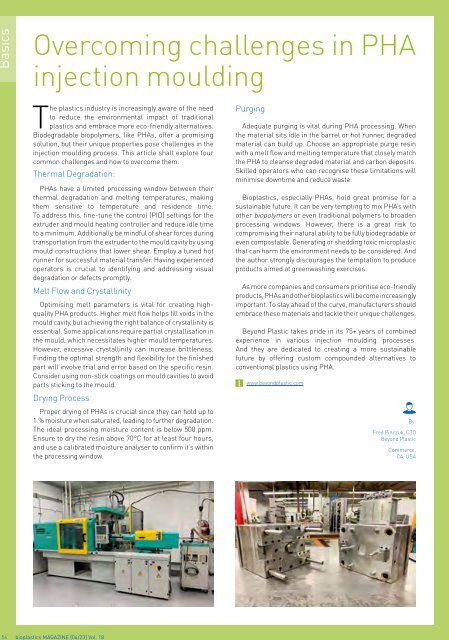Issue 04/2023
Highlights 100th issue Rebranding
Highlights
100th issue
Rebranding
Create successful ePaper yourself
Turn your PDF publications into a flip-book with our unique Google optimized e-Paper software.
56 bioplastics MAGAZINE [<strong>04</strong>/23] Vol. 18<br />
Basics<br />
Overcoming challenges in PHA<br />
injection moulding<br />
The plastics industry is increasingly aware of the need<br />
to reduce the environmental impact of traditional<br />
plastics and embrace more eco-friendly alternatives.<br />
Biodegradable biopolymers, like PHAs, offer a promising<br />
solution, but their unique properties pose challenges in the<br />
injection moulding process. This article shall explore four<br />
common challenges and how to overcome them.<br />
Thermal Degradation:<br />
PHAs have a limited processing window between their<br />
thermal degradation and melting temperatures, making<br />
them sensitive to temperature and residence time.<br />
To address this, fine-tune the control (PID) settings for the<br />
extruder and mould heating controller and reduce idle time<br />
to a minimum. Additionally, be mindful of shear forces during<br />
transportation from the extruder to the mould cavity by using<br />
mould constructions that lower shear. Employ a tuned hot<br />
runner for successful material transfer. Having experienced<br />
operators is crucial to identifying and addressing visual<br />
degradation or defects promptly.<br />
Melt Flow and Crystallinity<br />
Optimising melt parameters is vital for creating highquality<br />
PHA products. Higher melt flow helps fill voids in the<br />
mould cavity, but achieving the right balance of crystallinity is<br />
essential. Some applications require partial crystallisation in<br />
the mould, which necessitates higher mould temperatures.<br />
However, excessive crystallinity can increase brittleness.<br />
Finding the optimal strength and flexibility for the finished<br />
part will involve trial and error based on the specific resin.<br />
Consider using non-stick coatings on mould cavities to avoid<br />
parts sticking to the mould.<br />
Drying Process<br />
Proper drying of PHAs is crucial since they can hold up to<br />
1 % moisture when saturated, leading to further degradation.<br />
The ideal processing moisture content is below 500 ppm.<br />
Ensure to dry the resin above 70°C for at least four hours,<br />
and use a calibrated moisture analyser to confirm it’s within<br />
the processing window.<br />
Purging<br />
Adequate purging is vital during PHA processing. When<br />
the material sits idle in the barrel or hot runner, degraded<br />
material can build up. Choose an appropriate purge resin<br />
with a melt flow and melting temperature that closely match<br />
the PHA to cleanse degraded material and carbon deposits.<br />
Skilled operators who can recognise these limitations will<br />
minimise downtime and reduce waste.<br />
Bioplastics, especially PHAs, hold great promise for a<br />
sustainable future. It can be very tempting to mix PHA’s with<br />
other biopolymers or even traditional polymers to broaden<br />
processing windows. However, there is a great risk to<br />
compromising their natural ability to be fully biodegradable or<br />
even compostable. Generating or shedding toxic microplastic<br />
that can harm the environment needs to be considered. And<br />
the author strongly discourages the temptation to produce<br />
products aimed at greenwashing exercises.<br />
As more companies and consumers prioritise eco-friendly<br />
products, PHAs and other bioplastics will become increasingly<br />
important. To stay ahead of the curve, manufacturers should<br />
embrace these materials and tackle their unique challenges.<br />
Beyond Plastic takes pride in its 75+ years of combined<br />
experience in various injection moulding processes.<br />
And they are dedicated to creating a more sustainable<br />
future by offering custom compounded alternatives to<br />
conventional plastics using PHA.<br />
www.beyondplastic.com<br />
By:<br />
Fred Pinczuk, CTO<br />
Beyond Plastic<br />
Commerce,<br />
CA, USA

















